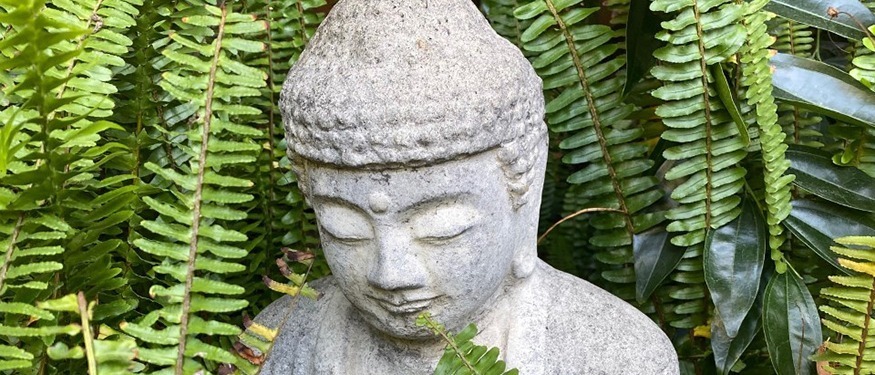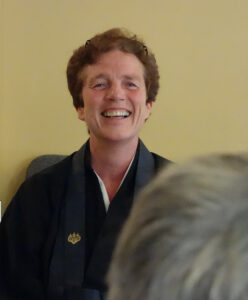
On Breathing Practice
January 1, 2023
 by Lorraine Gessho Kumpf
by Lorraine Gessho Kumpf
When we take the Introductory class at ZCLA, we start with posture and breathing. In my early experience at ZCLA, I saw our various practices as a progression through a curriculum: you start with counting the breath, then follow the breath, a teacher starts you on Mu, then dharmakaya koans, then the various other koan texts, etc. I expressed this once to Dharma Holder Goshin Naylor, who challenged my linearity by telling me, “You know of course, that for hundreds, probably thousands of years before there was koan practice or other practices we use, there was just breathing.” Of course, a study curriculum does exist, but breathing, he said, is also a complete practice, and one that is really limitless. This comment led me to ask, What kind of breathing practice did Shakyamuni Buddha teach his bhikkhus?
The Connected Discourses of the Buddha is part of the Pali Canon, the oldest records we have of the Buddha’s life. It contains the Buddha’s “Anapanasamyutta,” or “Connected Discourses on Breathing.” The first fascicle is titled “ONE THING,” and the first part is called “The One Thing.” Thus I get the feeling something fundamental is being taught. Here is a very short excerpt:
At Savatthi, there the Blessed One said this:
“Bhikkhus, one thing, when developed and cultivated, is of great fruit and benefit. What is the one thing? Mindfulness of breathing. And how, bhikkhus, is mindfulness of breathing developed and cultivated so that it is of great fruit and benefit?
“Here, bhikkhus: a bhikkhu, having gone to the forest, to the foot of a tree, or to an empty hut, sits down. Having folded his legs crosswise, straightened his body, and set up mindfulness in front of him, just mindfully he breathes in, just mindfully he breathes out.
“Breathing in long, he knows ‘I breathe in long;’ breathing out long, he knows ‘I breathe out long.’ Breathing in short, he knows ‘I breathe in short.’
“He trains thus: ‘Experiencing the whole body, I will breathe in.’ He trains thus: ‘Experiencing the whole body, I will breathe out.’ He trains thus: ‘Calming the bodily formations, I will breathe in.’ He trains thus: ‘Calming the bodily formations, I will breathe out.’
“He trains thus: ‘Experiencing rapture, I will breathe in.’ He trains thus: ‘Experiencing rapture, I will breathe out.’ He trains thus: ‘Experiencing happiness, I will breathe in.’ He trains thus: ‘Experiencing happiness, I will breathe out.’ He trains thus: ‘Experiencing mental formations, I will breathe in.’ He trains thus: ‘Experiencing mental formations, I will breathe out.’ He trains thus: ‘Calming mental formations, I will breathe in.’ He trains thus: ‘Calming mental formations, I will breathe out.’
“He trains thus: ‘Experiencing the mind, I will breathe in.’ He trains thus: ‘Experiencing the mind, I will breathe out.’
[This pattern repeats with]
“He trains thus: ‘Gladdening the mind…’
“He trains thus: ‘Concentrating the mind…’
“He trains thus: ‘Liberating the mind…’
“He trains thus: ‘Contemplating impermanence, I will breathe in.’
He trains thus: ‘Contemplating impermanence, I will breathe out.’
[This pattern repeats with]
“He trains thus: ‘Contemplating fading away…’
“He trains thus: ‘Contemplating cessation…’
“He trains thus: ‘Contemplating relinquishment…’
“It is, Bhikkhus, when mindfulness of breathing is developed and cultivated in this way that it is of great fruit and benefit.”
These breathing meditations concern the Four Contemplations: Contemplation of the Body (whole body, calming the body), Contemplation of Feelings (rapture, happiness, mental formations), Contemplation of Mind (the mind itself, gladdening the mind, concentrating the mind, liberating the mind), and Contemplation of Phenomena (the processes of extinguishing or ending life— impermanence, fading away, cessation, and relinquishment).
If we look at the Four Contemplations (body, feelings, mind, phenomena) from the standpoint of the Eight-fold Path, they map onto Right View, Right Effort, Right Mindfulness, and Right Concentration. Thus this breathing practice guides the intention of practitioners: it plants and cultivates the seeds of right understanding, and trains the body-mind to be directed toward, and to habituate oneself to, the fundamental teachings of the Path. It leads one away from “unwholesome states.” The Discourses continue to expand on this beginning text, explicating what exactly are the great fruits and benefits of the practice, along with other aspects of the meditation.
“If you completely follow your breath, each breath is the real life of everything.”
The amount of repetition in these discourses (which is barely represented here) may seem mind-numbing. But consider: these teachings were not written down. These sacred words were repeated over and over, generation after generation: it is the content of training. Also, all spiritual traditions use repetition so that the sacred words become embedded in the mind and bones of practitioners. Repetition impresses on people that something powerful is being said. Finally, in this, as in other preliterate societies, there
is an affinity for memorization. So memorizing the many fascicles of these teachings was a main mode of study.
What do we understand of these teachings? It’s a huge task to translate the words we attribute to the Buddha’s teachings. I’d say it’s impossible even for scholars to know about the context and lived experience of the ancients.
All words as we use them have a feeling tone as well as a field of meaning and usage, and the properties of word meaning and grammar are constantly changing, even in contemporary usage. What we have with the Discourses is centuries of translation through many different societies. Even the earliest texts we have are distant from the context of the Buddha. For example, Shakyamuni Buddha himself did not speak Pali—it is speculated that he spoke some version of Magada dialect—and it was approximately 300 years after the Buddha’s death before his words were written down.
Yet for all the traps of time and translation, the ancient breathing practice works for us. “Experiencing the whole body, I breathe in” is as fundamental as our physiology. It works because we live the same basic life, the same basic suffering, generation after generation. Practices of the ancients resonate for me because it is my life.
One modern Zen teacher, Vietnamese teacher Thich Nhat Hanh, used practices that are reminiscent of the Buddha’s method. His mindful breathing guided meditations were central to his teaching, as l learned from having attended practice periods with him.
Thich Nhat Hanh’s form of breathing meditation could be traditional, such as “Experiencing the whole body, I breathe in. Experiencing the whole body, I breathe out.” As you may know, he also spent his life as a peacemaker, working to counter violence and hatred. He used his form of mindful breathing to address social and psychological needs, for example: “Breathing in, I know that anger is in me. Breathing out, I take good care of my anger.” or “Seeing my father as a suffering child, I breathe in. Seeing my mother as a suffering child, I breathe out.” or “Contemplating a person in hatred, I breath in. Seeing the suffering of that person, I breathe out.” Thich Nhat Hanh translated the form into what he saw was needed.
Here is another approach to breathing practice, illustrated in a story from India (5th Century B.C.E.), of Bodhidharma’s teacher Prajnatara. Prajnatara was known as a master teacher, and she was invited to visit the ruler of a southern Indian kingdom. This ruler had a strong aspiration to practice Buddhism, and he wanted her to come and chant the sutras, so she came with her attendant.
But when the time for chanting came, only the attendant chanted—Prajnatara didn’t open her mouth. Later, when she was asked about it, she said that she’d been concentrating on her breathing: when she exhaled, she became one with exhalation; when she inhaled, she became one with inhalation. And in this way she was expounding the Dharma. She had practiced deep samadhi with her breathing—as she said, “the way breathing should be practiced. This is the same as chanting the sutras the way they should be chanted.” Prajnatara’s breathing was a complete practice. If you completely follow your breath, each breath is the real life of everything: by just breathing, Prajnatara was expounding the Dharma perfectly. On the surface, the function of breathing practice here seems different from the Buddha’s, but perhaps it is not—what do you think?
Breathing practices in India and in the subsequent Buddhist traditions can appear in different forms and through the lens of different cultures. The practices seem to be fundamental as means for quieting the mind and developing concentration. In Connected Discourses on Breathing, the Buddha’s methods give explicit guidance in the core teachings and aspiration toward right understanding. Though other teachers’ breathing practices may look different, all use the breath as an entryway to the harmony of body, breath, and mind.
Dharma Holder Gessho is a Preceptor and the Senior Resident.
